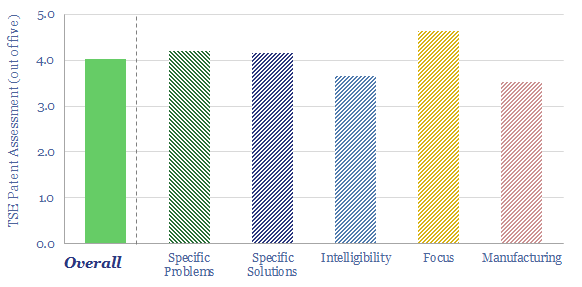A pressure exchanger transfers energy from a high-pressure fluid stream to a low-pressure fluid stream, and can save up to 60% input energy. Energy Recovery Inc is a leading provider of pressure exchangers, especially for the desalination industry, and increasingly for refrigeration, air conditioners, heat pump and industrial applications. Our technology review finds a strong patent library and moat around Energy Recovery’s pressure exchange technology.
Energy Recovery Inc was founded in 1992, it is headquartered in California, listed on NASDAQ, with 250 employees and $1.3bn of market cap at the time of writing. Financial performance in 2022 yielded $126M revenues, 70% gross margin, 20% operating margin.
The PX Pressure Exchanger is Energy Recovery Inc’s core product. It transfers pressure energy from a high pressure fluid stream to a low pressure fluid stream at 98% efficiency, yielding up to 60% energy savings in specific contexts. The company aims to grow revenues as much as 5x in the next half-decade due to increasing need for global energy efficiency.
Pascal’s Law states that bringing a high pressure and low pressure fluid into contact will result in their pressures equalizing with minimal mixing. This principle is used in pressure exchangers. As a rotor rotates, it brings a low pressure fluid A into contact with a high pressure fluid B, equilibrating their pressure, then discharging fluid A at higher pressure.
For example in a desalination plant, incoming seawater at 1-3 bar of pressure is pressurized up to 40-80 bar using pumps, pushing it across a membrane that is porous to water but not to dissolved salts. Energy remains in this 40-80 bar concentrate stream. It is better to recover this energy than blast it back into the Ocean! Thus pressure exchange can lower the energy requirements of desalination by as much as 60%.
Energy Recovery Inc’s patents note that rotary pressure exchangers were first invented in the 1960s, progressed in the 1990s, but prior to its own designs, the company argues that no one had designed efficient and reliable systems, which could run without an external motor to rotate them, achieved by optimizing the shape of the flow channels.
Our technology review found 65 patent families from Energy Recovery Inc. Overall, we think the patent library is high-quality and the company will retain a moat and leadership in the pressure exchange market, based on its patents and historical experience. Although some early patents are coming up to expiry. Details are in the data-file.
Desalination has been Energy Recovery’s core market historically. However new markets are emerging, from cryogenic cycles through to applications focused on shale (although the latter requires avoiding the corrosive impacts of sand and debris in fluid streams).

Refrigeration, air conditioning and heat pumps are seen as a growing source of demand. One patent notes that regulation is increasingly phasing out HFCs that can have 13,000x higher GWPs than CO2, and these systems use CO2 as the refrigerant instead. However CO2 based refrigeration cycles have maximum pressures of 1,500 psi or greater, compared to HFC/CFC systems at 200-300psi. This makes the energy savings from pressure exchange increasingly important, siphoning away a portion of the evaporated refrigerant and re-pressurizing it using high-pressure refrigerant downstream of the heat rejection stage, before the expansion valve stage.

